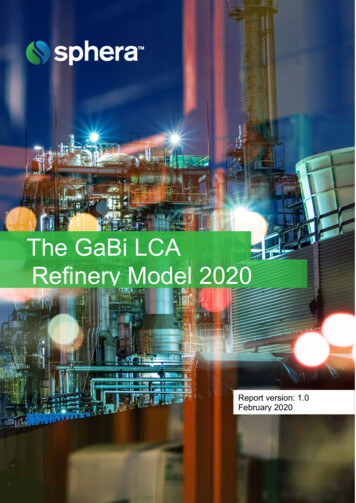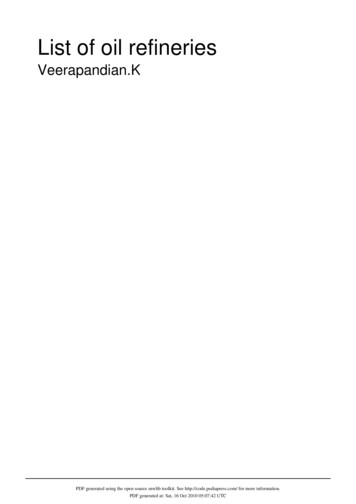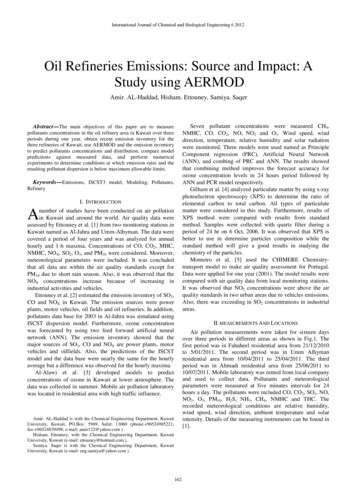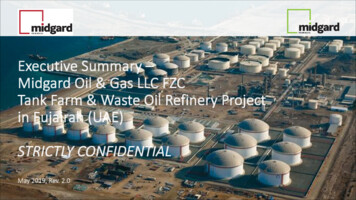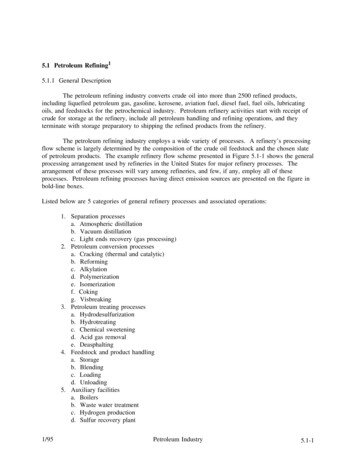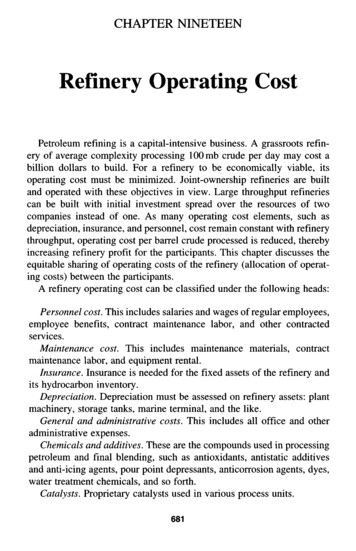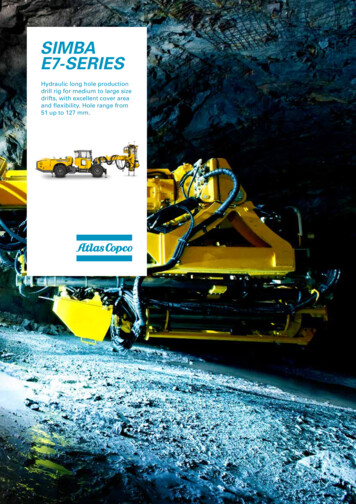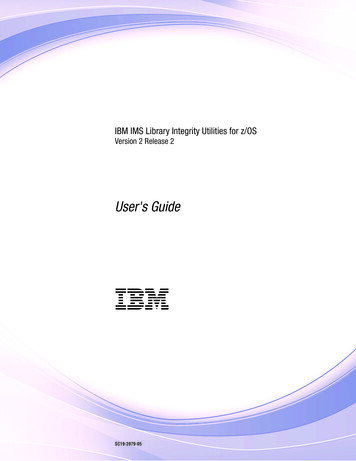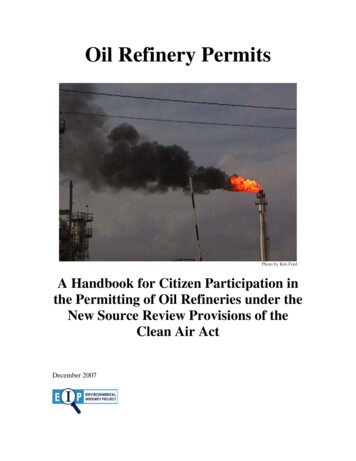
Transcription
Oil Refinery PermitsPhoto by Ken FordA Handbook for Citizen Participation inthe Permitting of Oil Refineries under theNew Source Review Provisions of theClean Air ActDecember 2007
Oil Refinery PermitsA Handbook for Citizen Participation in thePermitting of Oil Refineries under the New SourceReview Provisions of the Clean Air ActAuthor: Benjamin J. WakefieldCounsel, Environmental Integrity ght 2007, The Environmental Integrity ProjectThe Environmental Integrity Project (EIP) is a nonpartisan, nonprofit organizationestablished in March of 2002 by former EPA enforcement attorneys to advocate for moreeffective enforcement of environmental laws. EIP has three objectives: 1) to provideobjective analyses of how the failure to enforce or implement environmental lawsincreases pollution and affects the public’s health; 2) to hold federal and state agencies,as well as individual corporations, accountable for failing to enforce or comply withenvironmental laws; and 3) to help local communities obtain the protection ofenvironmental laws. An electronic copy of this Manual can be downloaded free ofcharge from the EIP website at www.environmentalintegrity.org.
AcknowledgementsThis project received funding support from the Marisla Foundation. Such support doesnot indicate endorsement by the Marisla Foundation of the contents of this Handbook.“The ABCs of NSR – A Citizen’s Guide to the Clean Air Act’s New Source ReviewPermitting Process,” written by Laura Haight, et al., for the New York Public InterestResearch Group Fund, Inc., is an excellent guide to the law and process of the NSRprogram in general, upon which this Handbook has relied and to which it owes a greatdebt of gratitude. This Handbook has also relied upon “The Proof is in the Permit – Howto Make Sure a Facility in Your Community Gets an Effective Title V Air PollutionPermit,” an excellent and detailed guide to participation in the Clean Air Act Title Vpermitting process, written by Keri Powell, et al., for the New York Public InterestResearch Group Fund, Inc., and the Earth Day Coalition, Inc.This project was completed under the direction of EIP’s Executive Director, EricSchaeffer. EIP’s Senior Counsel, Karla Raettig, contributed to portions of the text. Inaddition, portions of the text are taken from EIP’s report, “Gaming the System – HowOff-the-Books Industrial Upset Emissions Cheat the Public Out of Clean Air” (EIP,August 2004), written principally by Kelly Haragan.Alex Sagady, of Alex J. Sagady and Associates, provided valuable expertise andconsultation regarding the technological processes involved in petroleum refining.Finally, thanks to Kathy Andria (American Bottom Conservancy), Bob Levy (IndustryProfessionals for Clean Air), Adam Babich and Michael Murphy (Tulane EnvironmentalLaw Clinic), and others for reviewing drafts of this Manual. Their comments greatlystrengthened the final product. Their listing does not constitute an endorsement of thecontent of this Manual.
Table of ContentsIntroduction . . 1How this Handbook is Organized . 4I.II.OVERVIEW OF NEW SOURCE REVIEW . . 6A.The Law . 6B.The Permitting Process . . 121.Background . . 122.Steps in the Process . 13REFINING 101 – A BRIEF INTRODUCTION TO HOWREFINERIES WORK . 17A.Desalting 18B.Fractional Distillation . 18C.Cracking 191.Thermal Cracking . . 192.Coking . . 203.Catalytic Cracking . . 21D.Catalytic Hydrocracking . . 22E.Heaters and Boilers . 22F.Wastewater Treatment . . 23G.Sulfur Recovery . . 24H.Flare System . . 25I.Leak Detection and Repair (LDAR) . 25J.Storage Tanks . . . 26i
III.KEY ISSUES IN CONSTRUCTION (“NSR”) REFINERYPERMITS . 26A.Issues Pertaining to both PSD and NA NSR ConstructionPermits . . 271.2.B.Emissions increases and NSR applicability . 27a.“Major Stationary Source” and “RegulatedNSR Pollutants” . . 29b.Physical or Operational Change . 29c.Significant Emissions Increase . . 29d.Significant Net Emissions Increase(a.k.a., “Netting”) . 33Monitoring, Recordkeeping, and Reporting . . 36a.Types of Monitoring Technology . . 37b.Practical Enforceability . 41i.Ambiguity . 41ii.Recordkeeping and Reporting . . 44iii.Permitted Non-Compliance . 44iv.Limiting “Credible Evidence” . . 453.“Startup, Shutdown & Maintenance” and “Upsets” 464.Environmental Justice . 505.Class I Area Impacts . . 51PSD Permit Issues 531.BACT Analysis . . 532.Air Quality Impact Analysis . . 563.Additional Impacts Analysis (Soil & Vegetation,Growth, and Visibility) . . 58ii
C.D.NA NSR Permit Issues . 591.LAER Analysis . 592.Emission Reductions / Offsets . 603.Demonstration of Compliance . . 614.Alternatives Analysis . . 62Specific BACT (PSD) and LAER (NA NSR) Technologiesto Seek in Oil Refinery Construction Permits . . 621.Refinery Heaters and Boilers . 632.Waste Flare Gas Systems 643.Fluidized Catalytic Cracker Regeneration Units . 654.Fugitive Emissions . . 665.Product Loading Racks and Marine Terminals . . 666.Wastewater Management Units . 677.Catalytic Refining Catalyst Regeneration Operation . 678.Internal and External Floating Roof Tanks . 689.Wastewater Treatment Plant Filter Press SludgeIncinerator 6810.Petroleum Coke Handling . . 6811.Monitoring . . 69Conclusion . 70AppendicesAppendix A: Summary of Issues and Comments for NSR PermitsAppendix B: BACT and LAER Technologies for Oil Refineriesiii
Appendix C: “Significant” Emission Increase Thresholds for “MajorModifications” Pursuant to 40 C.F.R. § 51.166(b)(23)(i)Appendix D: Ambiguous Language That May Indicate PracticalEnforceability ProblemsAppendix E: Unacceptable Credible Evidence-Limiting LanguageAppendix F: Minimum Criteria for Excess Emission Affirmative Defenses(Where Available)Appendix G: Key Steps in the “Top-Down” BACT DeterminationAppendix H: Petroleum Refining Process Flow ChartAppendix I: Mandatory Class I Areasiv
Oil Refinery PermitsA Handbook for Citizen Participation in thePermitting of Oil Refineries under the New SourceReview Provisions of the Clean Air ActIntroductionPetroleum refineries emit millions of pounds of air pollution that poses a seriousrisk of harm to human health and the environment and impairs the quality of life for thepeople living in nearby communities. Carcinogens and other pollutants are releaseddirectly into the predominantly low-income and minority neighborhoods that typicallyshare the refinery fencelines, and many refineries are located in areas that already do notmeet federal air quality standards set to protect public health. Further, the environmentalconsequences of refinery pollution range from acid rain to global warming.Common air pollutants released from oil refineries include volatile organiccompounds (VOCs),1 sulfur dioxide (SO2), nitrogen oxides (NOX), particulate matter(PM),2 carbon monoxide (CO), hydrogen sulfide (H2S), and sulfuric acid aerosol (or“mist”). Many of the pollutants emitted by refineries are “hazardous air pollutants”(“HAPs”), 3 such as benzene, 1,3 butadiene, hexane, 1,2,4-trichlorobenzene, toluene,xylenes, propylenes, naphthalene, carbon disulfide, carbonyl sulfide, seleniumcompounds, nickel compounds, chromium compounds, cadmium compounds, hydrogenfluoride (hydrofluoric acid (“HF”)), and formaldehyde.4 Many refinery pollutants arealso “OSHA carcinogens,”5 such as polycyclic aromatic hydrocarbons (“PAHs” or“polycyclic aromatic compounds” (“PACs”)), benzene, ethylbenzene, 1,3-butadiene,naphthalene, styrene, tetrachloroethylene, formaldehyde, and metals such as nickel and1Numerous VOCs emitted by refineries – such as benzene; 1,3 butadiene; toluene; and xylenes – are toxicair pollutants – those known or suspected to cause cancer or other serious human health problems.2“Particulate matter” includes “total suspended particulates” (“TSP”), PM10 (particulate matter between 2.5and 10 micrometers in diameter), and PM2.5 (particulate matter less than or equal to 2.5 micrometers indiameter).3HAPs are pollutants “which are known to be, or may reasonably be anticipated to be, carcinogenic,mutagenic, teratogenic, neurotoxic, which cause reproductive dysfunction, or which are acutely orchronically toxic or [which cause] adverse environmental effects whether through ambientconcentrations, bioaccumulation, deposition, or otherwise .” Clean Air Act § 112(b)(2), 42 U.S.C. §7412(b)(2).4See Clean Air Act § 112(b)(1), 42 U.S.C. § 7412. The original list of 189 HAPs promulgated as part ofthe Clean Air Act Amendments of 1990 can also be found at http://www.epa.gov/ttn/atw/orig189.html.5“OSHA carcinogens” are “[U.S. EPA Toxics Release inventory (‘TRI’)] chemicals that are classified ascarcinogens under the requirements of the Occupation Safety and Health Administration (OSHA) .” Seehttp://www.epa.gov/tri/chemical/.1
lead.6 In addition, oil refineries are one of the largest producers of greenhouse gases,including carbon dioxide (CO2), and methane (CH4).7Human health effects caused by these pollutants include premature death; cancer;respiratory illness; aggravation of heart conditions and asthma; permanent lung damage;reproductive, neurological, developmental, respiratory, and immunological problems;bio-mutations; and cardiovascular and central nervous system problems.8 Environmentaldamage caused by these pollutants includes global warming; acid rain; concentration oftoxic chemicals up the food chain; the creation of ground level ozone and smog; visibleimpairments that migrate to sensitive areas such as National Parks; and depletion of soilnutrients.9 Refinery emissions also reduce the quality of life for nearby communitieswith noise, foul odors, and periodic requirements to remain indoors until winds carrytoxic emissions away.In addition, a trend toward expanding, modifying, and building refineries toprocess “tar sands”10 from Canada is gaining momentum.11 Beneath the boreal forest12 of6See http://www.epa.gov/tri/chemical/carcinog.pdf.7This list of pollutants is by no means comprehensive. The EPA notes that “in 1993 the petroleum refiningindustry released and transferred a total of 482 million pounds of pollutants, made up of 103 differentchemicals.” EPA document EPA/310-R-95-013, “EPA Office of Compliance Sector Notebook Project –Profile of the Petroleum Refining Industry,” U.S. Environmental Protection Agency, Office of Enforcementand Compliance Assurance (Sept. 1995) at 42, available hereinafter “EPA Refinery Sector Notebook”).8EPA Office of the Inspector General, “EPA Needs to Improve Tracking of National Petroleum RefineryProgram Progress and Impacts” (June 22, 2004), Appendix D, available 4-P-00021.pdf (hereinafter “EPA OIG Report”).9Id.10Tar sands are also sometimes called “oil sands” (reflecting the desire of developers to promote a morebenign-sounding name), “extra-heavy crude,” or “heavy crude,” and consist of about 85% sand, clay, andsilt; 5% water; and 10% crude bitumen (the “tar” that can be converted to oil). Ann Bordetsky, et al.,“Driving It Home: Choosing the Right Path for Fueling North America’s Transportation Future” at 5(Natural Resources Defense Council, the Pembina Institute, and Western Resource Advocates, June 2007),available at asp (hereinafter “Driving It Home”). Thebitumen itself is so viscous that it does not flow at room temperature, and can be used as a sealant or pavingmaterial. Elizabeth Kolbert, “Unconventional Crude – Canada’s Synthetic-fules Boom,” The New Yorker,Nov. 12, 2007, at 46, abstract available 1112fa fact kolbert (hereinafter “UnconventionalCrude”).11A thorough discussion of “tar sands” is beyond the scope of this Handbook, but it is mentioned here tohighlight an emerging issue in the area of refinery expansion, and to point out a few of the alarmingenvironmental consequences of obtaining oil and gasoline from tar sands. For a more thorough discussionof this issue, see Driving It Home, supra note 10. See also, numerous documents and reports regarding tarsands from the Pembina Institute, available at http://www.oilsandswatch.org/, including Dan Woynillowicz,“Oil Sands Fever – the Environmental Implications of Canada’s Oil Sands Rush” (The Pembina Institute,Nov. 2005) at 22, available at http://pubs.pembina.org/reports/OilSands72.pdf (hereinafter “Oil SandsFever”).2
Alberta, Canada lays an area the size of Florida containing tar sands. Due to risinggasoline prices, these “bottom of the barrel” reserves have recently become commerciallyviable to extract, placing Canada second only to Saudi Arabia in oil reserves (and morethan Kuwait, Norway, and Russia combined).13 With some experts predicting the“peaking” of conventional oil production in the near future, and given the politicalstability of Canada relative to the Middle East, the petroleum industry is increasinglyeyeing Alberta as the next Saudi Arabia.14 However, the environmental costs of miningand refining tar sands are staggering. Mining the deposits lying relatively close to thesurface means clear-cutting and strip-mining huge portions of intact boreal forestecosystem, turning it into enormous open-pit mines as large as three miles wide and 200feet deep.15 In fact, “[i]n any given load of sands, only about 10 percent is bitumen [so] [f]or every barrel of synthetic crude , forty-five hundred pounds of tar sands haveto be dug up and separated.”16 To obtain deeper reserves, a water and energy-intensiveprocess of steam-injection, called “steam assisted gravity drainage” (“SAGD, pronounced“sag-dee”) is used. Each barrel of oil from tar sands requires 2.5 – 4 times as much waterto produce as does conventional oil,17 and nearly all of this water ends up in vast toxic12The Sierra Club has stated: “The northern boreal ecoregion accounts for about one third of [the earth’s]total forest area. It is comprised of a broad circumpolar band which runs through most of Canada, Russia,Scandinavia and parts of Northern Scotland.” See http://www.sierraclub.org/ecoregions/boreal.asp. TheNew Yorker also reports: “Spread over 1.4 billion acres, Canada’s boreal forest is considered one of thelargest still intact ecosystems on the planet.” Unconventional Crude, supra note 10.13Unconventional Crude, supra note 10.14For example, at the time of publication of this Handbook, ConocoPhillips plans to invest 4 billion in itshuge Wood River Refinery in Roxana, Illinois to process tar sands, British Petroleum (“BP”) plans toinvest 3 billion in its massive Whiting, Indiana refinery to process tar sands, Hyperion Resources iscontemplating building an enormous new 400,000 barrel per day refinery in South Dakota (sometimescalled the “Gorilla Project” due to its size) to process tar sands, Murphy Oil Corp. has plans for anenormous 6 billion, 7-fold expansion of its refinery on Lake Superior in Wisconsin to process tar sands,Marathon Petroleum Co. is planning a 1.9 billion expansion of its Detroit, Michigan refinery to process tarsands (and may also be considering tar sands expansions at its Robinson, Illinois; St. Paul Park, Minnesota;and Garyville, Louisiana refineries), and Husky Energy, Inc. may be considering a tar sands expansion ofits refinery in Lima, Ohio. In November of 2007, The New Yorker reported that “[over] the next fiveyears, investment in [Canadian tar sands development] is expected to amount to more than seventy-fivebillion dollars.” Unconventional Crude, supra note 10. See also, Russell Gold, “As Prices Surge, OilGiants Turn Sludge Into Gold,” Wall Street Journal, Mar. 27, 2006, at A1 (hereinafter “Sludge Into Gold”).“Synthetic crude” production from tar sands already “tops a million barrels a day,” and is expected todouble to 2010 and triple by 2015. Unconventional Crude, supra note 10.15Driving it Home, supra note 10, at 5. See also, Unconventional Crude, supra note 10: “Before miningbegins, everything above the feed – trees, bushes, grass, soil, rocks, wildlife – gets scooped up and cartedaway. (The material is delicately referred to as ‘overburden.’) [Suncor official Darin] Zandee said, ‘Wetry to move a million tons a day.’”16Unconventional Crude, supra note 10 (emphasis added).17Dan Woynillowicz and Chris Severson-Baker, “Down to the Last Drop – the Athabasca River and OilSands – Oil Sands Issue Paper No. 1” (The Pembina Institute, Mar. 2006) at ii, available athttp://pubs.pembina.org/reports/LastDrop Mar1606c.pdf (hereinafter “Down to the Last Drop”). ThePembina Institute elaborated in 2006: “Approved and operating oil sands operations are allowed towithdraw 349 million cubic metres (m3) of water per year – that’s enough water to meet the needs of a cityof two million people, a population twice the size of the City of Calgary. Planned oil sands projects will3
lakes (which the oil industry euphemistically calls “tailings ponds”). The CanadianNational Energy Board (a federal regulatory body), has explained that “[t]here iscurrently no demonstrated means to reclaim fluid fine tailings.”18 So far (and just gettingstarted), these “tailings ponds” comprise about 20 square miles of non-reclaimable toxiclakes of mining waste, so vast that they can be seen from space, where once was pristineforest.19 Tar sands extraction also requires an enormous amount of energy – in fact, “[s]omuch heat is required to separate the oil from the tar that Total [Petrochemicals] brieflyfloated the idea of building a nuclear-power plant [in Northern Canada],”20 and “for everythree barrels extracted via SAGD, one has, in effect, been consumed.”21 Perhaps mostimportantly, due to the huge amounts of energy needed to extract and refine tar sands,producing oil from tar sands releases approximately three times as much global-warmingcausing “greenhouse gas” as does conventional crude oil production.22Despite these significant consequences to public health and the environment, thepublic faces substantial barriers to participation in the permitting of oil refineries. Chiefamong these barriers are the burdensome tasks of wading through technically dauntingproposed permits and navigating the often Byzantine permitting processes; that is,determining when and how to be effectively heard. This Handbook presents a “plainEnglish” explanation of the permitting process and how to participate, as well as aconcise description of what to look for – and ask for – in a permit to operate an oilrefinery under the Clean Air Act.Clean Air Act permits issued to oil refineries are permits given to privatecompanies by our government on behalf of us to pollute the air that we breathe. Publicparticipation is a right, and effective participation makes a real difference in the qualityand stringency of the permits under which refineries must operate. Better permits mean acleaner global environment, as well as improved health and quality of life for the peoplewho must live with the refineries in their back yards.How this Handbook is OrganizedOil refineries are subject to two principal types of Clean Air Act permits: “NewSource Review” (“NSR”) permits (sometimes called “construction permits”) and “Titleincrease water withdrawals more than 50% higher to 529 million m3 per year – more water than is used bythe City of Toronto in a year.” Id.18Sludge Into Gold, supra note 14, at A1. See also, Unconventional Crude, supra note 10: “Suncor[alone] has nine such ponds, which collectively cover an area of eleven square miles.”19See Driving it Home, supra note 10, at 8, citing Oil Sands Fever, supra note 11, at 30.20Sludge Into Gold, supra note 14, at A1. The Energy Alberta Corporation may currently be seeking tobuild two nuclear reactors in Alberta. Unconventional Crude, supra note 10. Currently, natural gas is usedto generate such heat. The New Yorker reported in November of 2007 that “[i]t is estimated that by 2012tar-sands operations will consume two billion cubic feet of natural gas a day, or enough to heat all thehomes in Canada.” Id.21Id.22Driving it Home, supra note 10, at 7, citing Oil Sands Fever, supra note 11, at 22.4
V” permits (so called because they are issued pursuant to Title V of the Clean Air Act(“CAA” or “the Act”)).23 While the NSR construction permits impose new limits andrequirements, the Title V permit compiles all the requirements applicable to a facility(including the NSR permit requirements) into a single document and requires the refineryto assure compliance with the CAA and all permit requirements. Since Title V permitsincorporate the specific requirements of the NSR permits, there generally are not Title Vissues (apart from the NSR issues) which are specific to oil refineries. Therefore, thisHandbook addresses only citizen participation in the development and issuance of NSRconstruction permits, and does not address Title V issues. However, for an excellent anddetailed guide to participation in the Title V permitting process, see “The Proof is in thePermit – How to Make Sure a Facility in Your Community Gets an Effective Title V AirPollution Permit,” available at 1.pdf.24The first section of this Handbook provides an overview of the law and thepermitting processes involved in issuing NSR construction permits. The section on the“law” will explain what the permit is, what it is supposed to do, and where it fits in thebroader scheme of the Clean Air Act. The section on the “process” will explain how thepermitting authorities go about drafting and issuing the permits, and where and how inthe process the public can participate.25The second section will present a brief discussion of the major processes involvedin oil refining and identify the technology and pollutants associated with those processes.The third section of this Handbook will discuss the key issues that should beaddressed in refinery NSR permits, and/or raised by citizens in commenting on orchallenging proposed NSR permits for oil refineries. This section will include arecitation of the specific technologies to ask for, relevant to each of the main oil refineryprocesses.23Refineries are subject to a number of other provisions of the CAA as well, as noted below, including theNew Source Performance Standards (“NSPS”) which mandate “best demonstrated technology” (“BDT”),National Emission Standards for Hazardous Air Pollutants (“NESHAPs”) which mandate maximumachievable control technology (“MACT”) requirements for hazardous air pollutants (“HAPs”), andreasonably available control technology (“RACT”) requirements applicable to all existing refineries in nonattainment areas.24Keri Powell, et al., “The Proof is in the Permit – How to Make Sure a Facility in Your Community Getsan Effective Title V Air Pollution Permit,” (Larry Shapiro, ed., New York Public Interest Research GroupFund, Inc., and The Earth Day Coalition, Inc., June 19, 2000), available athttp://www.titlev.org/t5book.htm (hereinafter “Proof is in the Permit”).25This Handbook strives to present an overview of the federal NSR program sufficient to allow citizens tonavigate the permitting process, but does not attempt to address variations in state NSR programs.However, each state’s NSR program is incorporated into its “State Implementation Plan” (“SIP”), whichcan be found in the U.S. Code of Federal Regulations (“C.F.R.”) at 40 C.F.R. Part 52.5
“The ABCs of NSR - A Citizen’s Guide to the Clean Air Act’s New SourceReview Permitting Process”26 is an excellent guide to the law and process of the NSRprogram in general, upon which this Handbook has relied and to which it owes a greatdebt of gratitude. This Handbook does not attempt to reiterate that detailed discussion.Rather, following a brief overview of NSR law and process, this Handbook focuses onthe specific issues, particular to oil refineries, that should be addressed in refinery permitsand/or raised by citizens in commenting on or challenging refinery permits.Finally, Appendix A to this Handbook contains a concise “bullet point” summaryof the most important substantive items to watch for when reviewing and commenting ona proposed refinery NSR construction permit, and Appendix B contains a list of specifictechnologies to ask for with regard to particular refinery processes.I.OVERVIEW OF NEW SOURCE REVIEWA.The LawThe essence of the New Source Review (“NSR”) program, created as part of the1977 amendments to the Clean Air Act, is that major stationary sources of air pollutionmust not significantly degrade air quality in regions which already meet national airquality standards, and such sources must not add any new pollution in regions which donot meet such standards. Any “major stationary source”27 which is to be newly built, andany existing major source which intends to undergo a “major modification,”28 mustobtain an NSR permit before commencing construction, and the public must be affordedan opportunity to review and comment on the draft permit before issuance.29 That permit26“The ABCs of NSR - A Citizen’s Guide to the Clean Air Act’s New Source Review Permitting Process,”Laura Haight, Principal Author and Editor; Contributing Authors: Lisa F. Garcia, Jason K. Babbie, andKelly Haragan (New York Public Interest Research Group Fund, Dec. 2005) (hereinafter “ABCs of NSR”).27Oil refineries are considered “major stationary sources” if they emit 100 tons per year (“tpy”) or more ofany “criteria pollutants,” including “fugitive emissions.” See 40 C.F.R. § 52.21(b)(1)(i)(a). (“Criteriapollutants” and “fugitive emissions” are discussed below). In practice, there is almost certainly no questionthat every oil refinery in the United States qualifies as a “major stationary source.”28A modification is considered “major” if the “net increase” in emissions or potential emissions (discussedmore fully below) meets any of the thresholds for the various pollutants listed at 40 C.F.R. §51.166(b)(23)(i) (see Appendix C), or if the modification occurs within 10 kilometers of a “Class I area”(such as certain “wilderness areas” (see Appendix I) and the increased emissions would effect the airquality of the Class I area by increasing the 24-hour average concentration of any regulated pollutant in theambient air by at least one microgram per cubic meter (1 µg/m3). 40 C.F.R. § 52.21(b)(23)(iii).29Note that the NSR thresholds regarding construction of “new” facilities are different from thoseregarding “major modifications” of existing facilities. A newly constructed refinery (built from scratch)would require an NSR permit if it met the 100 tpy threshold, but a “major modification” of an existing“major source” refinery would require an NSR permit if it met any of the “significant net increase”thresholds found at 40 C.F.R. § 52.21(b)(23)(i). Further, a modification to a “minor source” refinery wouldrequire an NSR permit only if the modification itself qualified as a “major source” (i.e., resulted in a netincrease of 100 tpy of any criteria pollutant), and a modification to “minor source” refinery which did notqualify as a “major modification” (i.e., as a “major source” in its own right for resulting in 100 tpy) wouldnot require an NSR permit, but would be relevant for future expansion permits if the total emissions thenqualified the refinery as a “major source.” However, the construction of new oil refineries is now6
will include requirements, among others, to install modern pollution control technology.Thus, one important aspect of the NSR program is that it gradually requires agingfacilities (those in existence in 1977 when the NSR program was enacted – i.e., all of thecurrent refineries in the U.S.) to install modern pollution control technology, whichcomplies with the requirements that would apply to any newly constructed facility, asthey upgrade or expand.30The Clean Air Act requires the U.S. Environmental Protection Agency (“EPA”)to establish national air quality standards with regard to six common air pollutants whichare known hazards to human health and the environment, called “criteria pollutants.”These “criteria pollutants” are sulfur dioxide (SO2), nitrogen oxides (NOX), carbonmonoxide (CO), particulate matter (PM), ground-level ozone (O3), and lead (Pb). The airquality standards applicable to the criteria pollutants are known as “National Ambient AirQuality Standards” (“NAAQS”). The Act further defines numerous “air quality regions,”which together encompass the entire United States. States monitor the criteria pollutantsin the air quality regions and report the results to the EPA. If a region meets the NAAQSfor a particular criteria pollutant, it is said to be an “attainment area” for that pollutant; ifa region does not meet the NAAQS for a pollutant, it is a “non-attainment area” for thatpollutant.31 The Clean Air Act seeks to protect the air quality in attainment areas, and tobring non-attainment areas into attainment.The NSR program treats facilities differently depending upon whether they are inan “attainment are
10 Tar sands are also sometimes called "oil sands" (r eflecting the desire of developers to promote a more benign-sounding name), "extra-heavy crude," or "heavy crude," and consist of about 85% sand, clay, and silt; 5% water; and 10% crude bitumen (the "tar" th at can be converted to oil). Ann Bordetsky, et al .,
